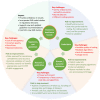CODE-EHR best practice framework for the use of structured electronic healthcare records in clinical research
- PMID: 36208161
- PMCID: PMC9452067
- DOI: 10.1093/eurheartj/ehac426
CODE-EHR best practice framework for the use of structured electronic healthcare records in clinical research
Abstract
Big data is central to new developments in global clinical science aiming to improve the lives of patients. Technological advances have led to the routine use of structured electronic healthcare records with the potential to address key gaps in clinical evidence. The covid-19 pandemic has demonstrated the potential of big data and related analytics, but also important pitfalls. Verification, validation, and data privacy, as well as the social mandate to undertake research are key challenges. The European Society of Cardiology and the BigData@Heart consortium have brought together a range of international stakeholders, including patient representatives, clinicians, scientists, regulators, journal editors and industry. We propose the CODE-EHR Minimum Standards Framework as a means to improve the design of studies, enhance transparency and develop a roadmap towards more robust and effective utilisation of healthcare data for research purposes.
This article has been co-published with permission in The BMJ, the Lancet Digital Health, and the European Heart Journal © the Authors 2022.
Figures


References
-
- Wallentin L, Gale CP, Maggioni A, Bardinet I, Casadei B. EuroHeart: European Unified registries on heart care evaluation and randomized trials. Eur Heart J 2019;40:2745–9. - PubMed

